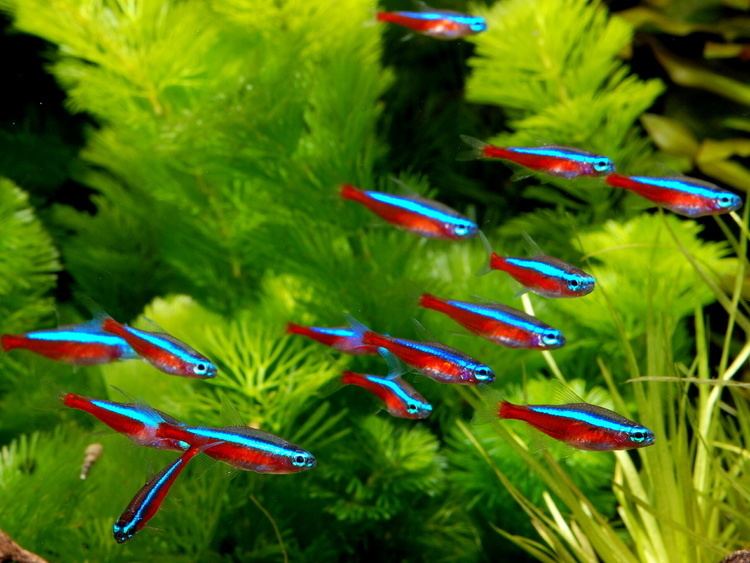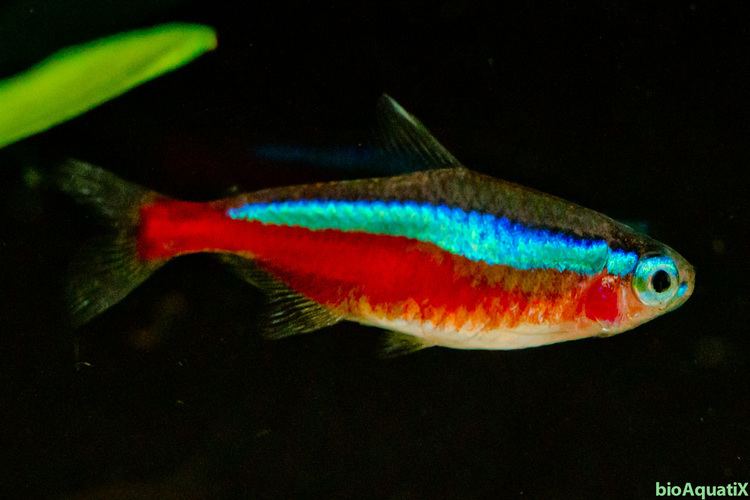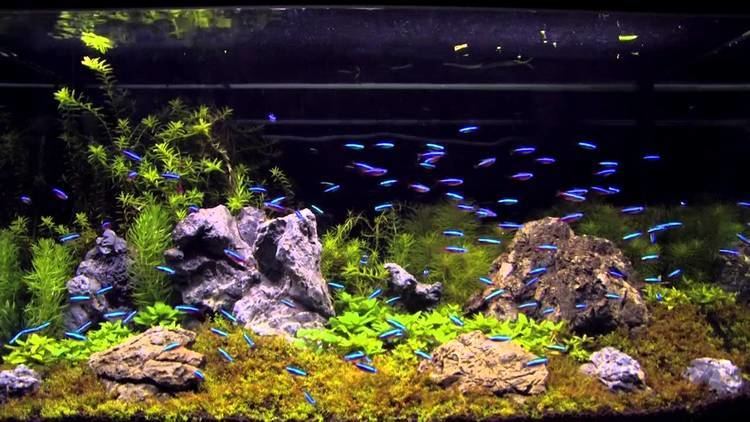Phylum Chordata Scientific name Paracheirodon axelrodi Rank Species | ||
 | ||
Similar Neon tetra, Paracheirodon, Cory catfish, Freshwater angelfish, Ram cichlid | ||
5 min fish facts cardinal tetras
The cardinal tetra (Paracheirodon axelrodi) is a freshwater fish of the characin family (family Characidae) of order Characiformes. It is native to the upper Orinoco and Negro Rivers in South America. Growing to about 3 cm (1.2 in) total length, the cardinal tetra has the striking iridescent blue line characteristic of the Paracheirodon species laterally bisecting the fish, with the body below this line being vivid red in color, hence the name "cardinal tetra". The cardinal tetra's appearance is similar to that of the closely related neon tetra, with which it is often confused; the neon's red coloration extends only about halfway to the nose, and the neon's blue stripe is a less vibrant blue.
Contents
- 5 min fish facts cardinal tetras
- 100 cardinal tetra in an aquascaping tank
- Taxonomy
- Description
- Feeding
- Breeding and lifespan
- Development
- Aquarium maintenance
- References

The cardinal tetra is a very popular aquarium fish, but is less widespread than the neon tetra because until recently, it was difficult to breed in captivity. However, many breeders are now producing the fish; in most cases one can determine if the cardinal tetra is bred or wild-caught due to damaged fins on wild caught specimens. Normally, aquarists prefer to buy tank-bred fish, but some Brazilian ichthyologists believe fishkeepers should continue to support the sustainable cardinal fishery of the Amazon basin, since thousands of people are employed in the region to capture fish for the aquarium trade. If those fishermen lost their livelihoods catching cardinals and other tropical fish, they might turn their attention to engaging in deforestation.

100 cardinal tetra in an aquascaping tank
Taxonomy
American ichthyologist Leonard Peter Schultz described the cardinal tetra in 1956 as Cheirodon axelrodi. The specific epithet honors ichthyologist Herbert R. Axelrod. Hyphessobrycon cardinalis is an obsolete synonym. The fish's common name, cardinal tetra, refers to the brilliant red coloration, reminiscent of a cardinal's robes. P. axelrodi is also often called the red neon tetra.

The species exists in a number of different color forms or phenotypes. A "gold" and "silver-blonde" form exist in the Rio Negro drainage which has less blue in the longitudinal stripe. The normal form from the Rio Negro drainage has a blue stripe which extends to the adipose fin, while the Orinoco drainage phenotype has a stripe which stops posterior to the adipose. The Orinoco phenotype may represent a subspecies of P. axelrodi.
Description

The cardinal tetra has bright red ventral parts and an iridescent blue line that runs horizontally down the length of its body. The characteristic iridescence of this and related fishes, such as the neon tetra, is a structural color, caused by refraction of light within guanine crystals that develop within special cells called iridocytes in the subcutaneous layer. The exact shade of blue seen will depend on the viewing angle of the aquarist relative to the fish - if the aquarist changes viewpoint so as to look at the fish more from below, the colour will change hue, becoming more deeply sapphire blue and even indigo. Change the viewpoint to one above the fishes, however, and the color becomes more greenish. Cardinal tetras appear to grow larger in captivity than they do in the wild. They have a large stomach and small gut.
Feeding

The cardinal tetra forages in areas of slow-moving shallow water. It is predominantly predatory, generally feeding on tiny animals they find on underwater plants, roots and leaf litter. Creatures commonly eaten include the larvae of chironomid midges and microcrustaceans such as water fleas (Cladocera) of the families Moinidae, Macrotrichidae and Daphniidae, and Copepods of the family Harpacticidae. Other organisms eaten include other fly larvae, insect eggs, rotifers and testate amoebae.
Breeding and lifespan
The cardinal tetra, in the wild, swims upstream in large numbers to parts of its native river habitat completely enclosed above by rainforest canopy. Such waters are subject to heavy shading by the rainforest trees, and virtually no sunlight reaches them. Here, the fishes spawn in large aggregations. In the aquarium, a single pair can be conditioned for breeding, but the breeding aquarium not only needs to contain water with the correct chemical parameters cited above, but the breeding aquarium also needs to be heavily shaded to mimic the low light conditions of the fish's native spawning grounds. If the fishes are ready to spawn, the male, which will be the slimmer of the two fishes in outline, will pursue the female into fine-leaved plants; her fuller outline, which usually indicates the presence of ripe eggs within her reproductive tract, should be readily apparent at this point. If the female is ready, she will allow the male to swim alongside her, and together, the pair will release eggs and sperm.
The fish might also be effectively an annual species with a lifespan of just a single year in nature. It lives for several years in captivity.
Development
If the eggs are fertile, and kept in darkened surroundings, they hatch in about three days at 28 °C (82 °F). Free-swimming fry remain photosensitive for at least the first seven days of life, and need to be introduced to increasing light levels on a gradual basis. During this time, they are approximately 4 mm in length, and require infusoria or liquid fry food. Newly hatched brine shrimp and other similar live foods, such as sifted Daphnia, can be fed to the growing fry at between seven and 14 days of age. Growth continues at a modest rate, and the fishes assume full adult colouration only after a period of around eight to 12 weeks, depending upon quality of food and aquarium water.
Aquarium maintenance
An entire industry is in place in Barcelos on the banks of Brazil's Rio Negro in which the local population catches fish for the aquarium trade. The cardinal fishery here is highly valued by the local people who act as stewards for the environment. The local people may not become involved in potentially environmentally damaging activities, such as deforestation, because they can make a sustainable living from the fishery.
Perhaps due to their wild-caught origins, cardinal tetras tend to be somewhat delicate in captivity. In the wild, these fish inhabit extremely soft, acidic waters, but seem to be tolerant of harder, more alkaline water conditions; a greater concern is probably polluted tank water (including high nitrate levels). They prefer warmer water temperatures [above 24 °C (75 °F) or warmer], and will readily accept most forms of dry food. Captive-bred cardinals tend to adapt to hard water better than wild-caught cardinals.
Given the origins of the cardinal tetra, namely blackwater rivers whose chemistry is characterised by an acidic pH, low mineral content and the presence of humic acids, the species is adaptable to a wide range of conditions in captivity, though deviation from the soft, acidic water chemistry of their native range will impact severely upon breeding, fecundity, and life expectancy. The preferred temperature range of the fish is 26 to 28 °C (79 to 82 °F). However, if necessary they will live at 24 °C (75 °F). The water chemistry of the aquarium water should match that of the wild habitat - filtration of the aquarium water over peat is one means of achieving this, as is the use of reverse osmosis water.
A study conducted in Manaus, Brazil subjected cardinal tetra to adverse water conditions for 96 hours. It found that fish perished at a low temperature of 19.6 °C and high of 33.7 °C, and pH below 2.9 or above 8.8.
As the species is a shoaling species in the wild, groups of six or more individuals should be maintained in an aquarium although bigger groups are preferred. They will shoal with their close cousins neon tetras, though, so a combination of these two species totalling at least six should suffice (again, larger groups are preferred). Tank currents can help encourage shoaling behavior. The larger the numbers present in an aquarium (subject to the usual constraints imposed by space and filtration efficiency), the better, and large shoals in any case form an impressive and visually stunning display.
The species will feed on a wide range of aquarium foods, though again, conditioning fishes of this species for breeding will usually require the use of live foods such as Daphnia.
Apart from the stringent requirements with respect to water chemistry, one of the major difficulties in captive breeding of the species is the photosensitivity of the eggs; they will die if exposed to bright light. Consequently, after spawning, the fishes should be removed and the aquarium covered to darken it, thus providing the developing eggs with the conditions necessary for development.
Aquarium furnishings should be planned with some care. Live aquatic plants, as well as providing additional biological filtration components to assist with nitrate management, provide an environment that resembles at least part of the wild habitat, and fine-leaved plants such as Cabomba are usually the plants of choice, though other plants such as Amazon swordplants and Vallisneria are equally suitable for an aquarium housing them. Floating plants providing shade will also be welcomed by the species; this is connected with the breeding of the fish. A perfect biotope to promote breeding would be bogwood, a few live native plants, dark substrate and subdued lighting with floating plants.
